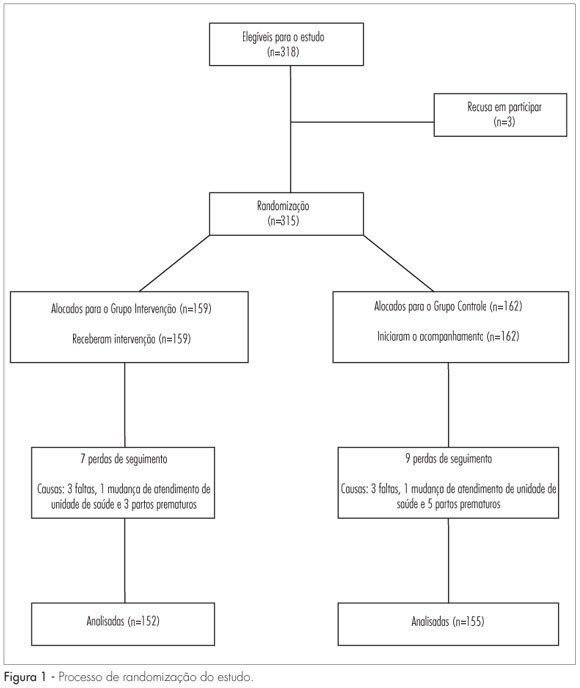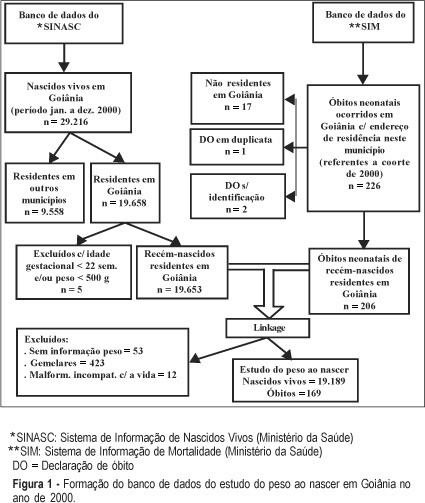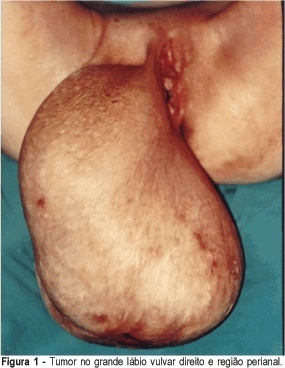Summary
Revista Brasileira de Ginecologia e Obstetrícia. 2002;24(2):129-132
DOI 10.1590/S0100-72032002000200009
Hepatic rupture is one of the most serious and catastrophic complications of pregnancy, with an estimated incidence of 1:45000 to 1:225000 deliveries. It is usually associated with preeclampsia. Maternal mortality is about 60-86% and fetal mortality can reach 56-75%. Diagnosis is difficult, but commonly relies on the presence of severe bleeding and hypovolemic shock. We present the case of a patient with a 32-week gestation complicated by spontaneous preeclampsia-associated hepatic hemorrhage, which was submitted to surgical treatment with good outcome.
Summary
Revista Brasileira de Ginecologia e Obstetrícia. 2011;33(1):13-19
DOI 10.1590/S0100-72032011000100002
PURPOSE: to evaluate the impact of dietary counseling on controlling weight gain in pregnant women, who were served in a public health service facility. METHODS: the study was conducted at a known health unit located in the metropolitan region of the city of Porto Alegre, in Rio Grande do Sul, Brazil. Three hundred and fifteen pregnant women between the 10th and 29th week of gestation were randomized to Control and Intervention Groups. The Intervention Group received dietary counseling according to nutritional status, and pregnant women in the Control Group were instructed to follow the routine of the health service facility. Weight and height were measured, and the body mass index (BMI) was calculated. The pre-gestational nutritional status was determined according to the following BMI criteria: low weight (<18.5 kg/m²), eutrophy (18.5 to 24.9 kg/m²), overweight (25.0 to 29.9 kg/m²), and obesity (>30 kg/m²). The nutritional status during pregnancy was determined according to the BMI curve for gestational age adopted by the Health Ministry of Brazil. Data were analyzed by the relative risk and respective 95% confidence interval, and by the Student's t-test and χ2 test. Statistical significance was set at p<0.05. RESULTS: the assessment of nutritional status before pregnancy showed that 28.0% of the women were overweight and 4.1% were underweight. In the first and last interview during pregnancy, the rates of prevalence of excessive weight were 36.2 and 46.0%, respectively. The intervention proved to be effective in reducing the rate of weekly weight gain of pregnant women with excess weight (342.2 versus 420.2; p=0.015) and the prevalence of clinical complications (9.2 versus 24.85; p<0.001). CONCLUSIONS: dietary counseling was effective in decreasing the weight gain of pregnant women who were overweight and reducing clinical complications, such as gestational diabetes, preeclampsia, infant low weight, and prematurity in the Intervention Group.

Summary
Revista Brasileira de Ginecologia e Obstetrícia. 1999;21(1):13-17
DOI 10.1590/S0100-72031999000100003
Purpose: to evaluate if the nipple stimulation performed by primigravidae, at 40 weeks, modifies Bishop index. Method: 64 primigravidae, without clinical or obstetrical complications were studied, in two groups. One group, called nipple stimulation group (N.S.G.) had 29 pregnant women. The other, named control group (C.G.) included 35 pregnant women. The N.S.G. performed the nipple stimulation test, bilaterally, from left to right, for two minutes followed by five minutes of rest, during thirty minutes. The test was done three times a day up to 41 weeks of pregnancy or beginning of labor. Statistical analysis of the results was performed using Student's t test, with 5 % significance. Results: once nipple stimulation was completed in the N.S.G., it was compared with the C.G. considering time of delivery. The results showed no significant differences between the groups regarding cervix modification, according to the Bishop index. Conclusions: there were no differences of the Bishop index in primigravidae, with more than 40 weeks of pregnancy, who performed nipple stimulation test, when compared with pregnant women of the control group.
Summary
Revista Brasileira de Ginecologia e Obstetrícia. 2000;22(1):13-17
DOI 10.1590/S0100-72032000000100003
Purpose: to determine magnesium sulfate effectiveness to prevent eclamptic seizures in pregnant women diagnosed with preeclampsia. Methods: a case-control study involving 489 pregnant patients admitted to the Hospital de Clínicas de Porto Alegre (HCPA) with the diagnosis of hypertension between January 1990 and January 1997. The patients were divided into two groups: those who received magnesium sulfate (Group I) and those who did not (Group II). All patients were treated according to the hospital's standard protocol for the treatment of hypertensive pregnant women. The following variables were assessed: maternal age, race, number of seizures, number of seizures in patients receiving magnesium sulfate, period of magnesium sulfate administration, before and after delivery, maternal mortality, need of ICU care, need of mechanical ventilation and length of hospital stay after delivery. Data were assessed with Epi-Info 6.0 statistical package, using multivariate analysis. The main outcome measure was magnesium sulfate use. Results: no differences were found between the two groups in terms of maternal age, race or gestational age. Women who received magnesium sulfate had a higher mean systolic and diastolic blood pressure. Women in the intervention group had a longer hospital stay and a greater need of ICU care. Need of mechanical ventilation and maternal mortality were similar in the two groups. Twenty-two out of 353 women had one or more seizures before admission to the hospital. Six women (27.3%) had one or two additional seizures after magnesium sulfate administration. No subjects had three or more seizures after receiving magnesium sulfate. Conclusion: the results show that eclamptic seizures can be prevented by routine prophylactic magnesium sulfate administration.
Summary
Revista Brasileira de Ginecologia e Obstetrícia. 1998;20(1):13-18
DOI 10.1590/S0100-72031998000100003
The parpose of the present report was to determine the maternal mortality rate in São Paulo, the most frequent pathologies which caused death and the distribution of cases paccording to age. In thepresent retrospective study 179,872 death certificates from April 1993 to December 1995 of women from 10 to 49 years old. Were reviewed 761 death certificates were selected, in which the pregnancy state was either declared or presumed; pregnancy was confirmed in 291/761 cases and 53/761 cases are still under investigation. The data were tabulated, grouped and analyzed considering the age and cause of death, according to the 9th revised edition of ICD - International Classification of Diseases. Of the 291 positive cases, 82 (28.17%) did not show any reference to the pregnancy state in the death certificate (undernotification); 183/291 cases (62.89%) were direct maternal deaths and the main diseases leading to maternal death were: hemorrhage (47/183), preeclampsia-eclampsia (46/183) and abortion complications (43/183). Among the indirectly related causes of maternal death (79/291), cardiopaty was the most frequent (33/79). Hypertensive syndrome (preeclampsia-eclampsia and/or chronic arterial hypertension) were responsible for 58/291 cases (19.93%) of maternal deaths. This study allowed us to calculate the maternal mortality rate for São Paulo: 50.24:100,000 live births.
Summary
Revista Brasileira de Ginecologia e Obstetrícia. 2013;35(3):130-135
DOI 10.1590/S0100-72032013000300007
PURPOSE: It was to determine the prevalence of depressive symptoms in a sample of puerperal women from Brasília, Brazil, distinguishing cases with onset after delivery from those already present during pregnancy. METHODS: A prospective cohort study with convenience sampling of patients submitted to elective cesarean section at two private hospitals. As an instrument for assessing depressive symptoms, the Edinburgh Postnatal Depression Scale with cutoff >13 was applied shortly before delivery and four to eight weeks after childbirth. RESULTS: Among the 107 women who completed the study, 11 (10.3%) had significant depressive symptoms during pregnancy and 12 (11.2%) during the postpartum period. Among the 12 patients with postpartum symptoms, 6 had symptoms during pregnancy, so that 5.6% of the sample had postpartum onset of depression. The higher overall frequency of depression was significantly among single women than among married women (p=0.04), a fact mainly due to a higher frequency of single women experiencing persistent depressive symptoms both before and after delivery (p=0.002). The risk of depression was not influenced by age, parity or educational level. CONCLUSION: Women with depression identified during the postpartum period comprise a heterogeneous group, in which symptoms may have started before pregnancy, during pregnancy or after childbirth. In this sample, half of the postpartum depression cases already presented symptoms during late pregnancy. Since depression can arise before and after childbirth, it may have different etiologies and, therefore, a different response to treatment, a possibility that should be considered by clinicians and researchers.
Summary
Revista Brasileira de Ginecologia e Obstetrícia. 2005;27(3):130-136
DOI 10.1590/S0100-72032005000300006
PURPOSE: to analyze birth weight in a cohort of newborns for the year 2000, in Goiânia, by determining the coefficient of mortality and neonatal survival probability, stratified by categories of birth weight, and also, through the identification of factors associated with low birth weight (LBW). METHODS: a retrospective cohort study, made possible by the linkage of data from the ISM (Information System on Mortality) and ISLB (Information System on Live Births) files. Coefficients of neonatal mortality were calculated for the categories of birth weight and a neonatal survival probability chart was constructed with the help of linear regression analysis. Risk factors for LBW were identified by univariate analysis (RR) and logistic regression analysis, and the level of significance was set at 5%. RESULTS: the incidence of LBW was 6.9% and 140 (66.8%) neonatal deaths took place in this group. Thirty percent of these deaths occurred in the 1,500-2,500 g weight bracket. The following risk factors were identified for LBW: preterm pregnancy, presence of congenital malformations, mothers at the extreme ages for reproduction, mothers living in the northwestern region of the city, insufficient prenatal appointments with the doctor, delivery in a public hospital, and female babies. CONCLUSION: Goiânia had an incidence of LBW which is comparable to that of developed countries and coefficients of neonatal mortality by category of weight were below those found for those countries. These results recommend that we pay attention to: prematurity, public hospitals, and the northwestern region of Goiânia.

Summary
Revista Brasileira de Ginecologia e Obstetrícia. 2003;25(2):131-135
DOI 10.1590/S0100-72032003000200009
Liposarcoma is a rare neoplasia that originates from primitive mesenchymal cells and is the most common histological type of sarcoma. It mainly affects the limbs but can reach other regions. Genital localization is, however, rare. The authors report a case of vulvar liposarcoma in a 27-year-old patient, who presented a progressively growing mass that limited her movements. Physical examination showed a large ulcerated vulvar tumor. The patient underwent local resection and histopathological examination diagnosed a well-differentiated liposarcoma with uncompromised margins. At the present time, 24 months after surgery, the patient is well and without recurrence of the disease.
